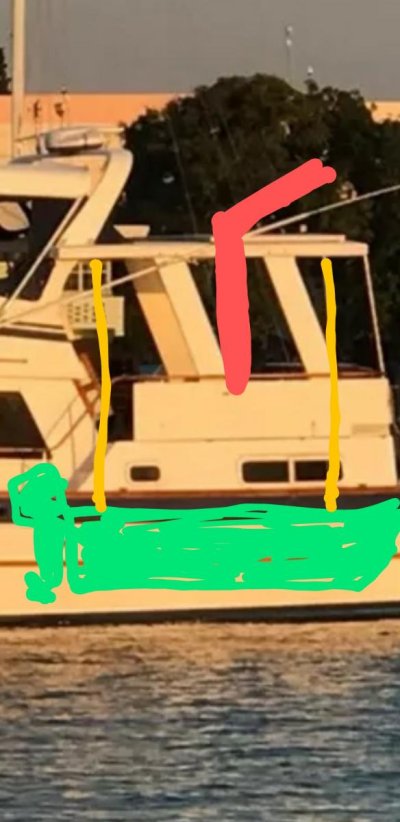I attached a couple photos to clearly demonstrate what I'm considering.
I just installed a davit (red in drawing) to lift my 1000lb skiff. I need to install a new engine and paint the bottom. There isnt really any spare room on the hardtop to work on it up there. I was thinking I could install 2 heavy duty diamond pad eyes on the underside of the hardtop the same distance apart as the bow & aft lift points on the skiff. Then i would lift the skiff with the davit. Attach the (yellow) lines. Then let out the cable on the davit until the lines were holding the skiffs weight. Then the davit would be free to hoist the new engine into position. Also when painting the skiff (from a dinghy in the water), instead of hanging out on the arm of davit for 2 days, the skiff would just be pulling almost directly vertically on the lines from the pad eyes in hardtop. That seems to me like it would be less strain(?), but I'm not an engineer...
The hardtop looks to be 1 inch balsa core with not alot of fiberglass on each side. I would need some serious backing plates on the topside of the hard top for the pad eyes.
My friend says I should just install the engine with the skiff in the water, and paint the bottom while it is dangling from the davit.
Looking for input from the peanut gallery. Particularly, if the cored hardtop is strong enough for the compression forces and how thick/large of backing plate it would require?
I just installed a davit (red in drawing) to lift my 1000lb skiff. I need to install a new engine and paint the bottom. There isnt really any spare room on the hardtop to work on it up there. I was thinking I could install 2 heavy duty diamond pad eyes on the underside of the hardtop the same distance apart as the bow & aft lift points on the skiff. Then i would lift the skiff with the davit. Attach the (yellow) lines. Then let out the cable on the davit until the lines were holding the skiffs weight. Then the davit would be free to hoist the new engine into position. Also when painting the skiff (from a dinghy in the water), instead of hanging out on the arm of davit for 2 days, the skiff would just be pulling almost directly vertically on the lines from the pad eyes in hardtop. That seems to me like it would be less strain(?), but I'm not an engineer...
The hardtop looks to be 1 inch balsa core with not alot of fiberglass on each side. I would need some serious backing plates on the topside of the hard top for the pad eyes.
My friend says I should just install the engine with the skiff in the water, and paint the bottom while it is dangling from the davit.
Looking for input from the peanut gallery. Particularly, if the cored hardtop is strong enough for the compression forces and how thick/large of backing plate it would require?



